Wireless Seismic 00103 Wireless Remote Unit User Manual DeploymentGuide
Wireless Seismic, Inc. Wireless Remote Unit DeploymentGuide
Contents
- 1. Users Manual 1
- 2. Users Manual 2
Users Manual 2

Draft
RT System 2 v2.0.0 58 Deployment Guide R00.e
© 2010-2012 Wireless Seismic, Inc. All rights reserved.
4
4. Demobilization
4.1 Overview
This chapter describes how to prepare (undeploy) the ground electronics for
transport at the end of a project (demobilization).
4.2 Removing the WRU from the Field
This section describes the process to ready the WRU for movement to a new
physical location or to remove it in preparation for demobilization.
To undeploy the WRU:
1Prerequisites:
●The WRU is assembled with battery, geophone, and antenna
●The WRU is in an active, transitional, or ready state
2Pick up the WRU and point the geophone connector end towards the sky as
shown in the following figure. All of the LEDs illuminate:
3Place the unit flat in the transportation vehicle as shown in the following
figure. The unit shuts down. The LEDs on the top of the unit are off.
Figure 4–1 Power Off the
Unit

Draft
R00.e RT System 2 v2.0.0 Deployment Guide 59
© 2010-2012 Wireless Seismic, Inc. All rights reserved.
4. Demobilization
Disassemble the WRU
4Optional: Remove batteries, antenna, or geophone as described in
“Disassemble the WRU” on page 59.
4.3 Disassemble the WRU
This section describes the process to disassemble the WRU prior to demobilization.
To disassemble the WRU:
1Undeploy the equipment as described in “Removing the WRU from the Field” on
page 58.
2Remove the antenna from the unit.
3Remove the geophone from the unit.
4Remove the batteries from the unit.
●Press the catch on the battery latch.
●Lift the lever, but do not lift the bail from the molded area on the battery.
Figure 4–2 Undeployed Unit

Draft
60 RT System 2 v2.0.0 Deployment Guide R00.e
© 2010-2012 Wireless Seismic, Inc. All rights reserved.
4. Demobilization
Disassemble the WRU
●Continue to lift the lever using the bail to push the battery out of the
connector.
5Secure the equipment in the transport vehicle.
Figure 4–3 Removing the Battery

Draft
RT System 2 v2.0.0 61 Deployment Guide R00.e
© 2010-2012 Wireless Seismic, Inc. All rights reserved.
5
5. Maintaining the Equipment
5.1 Units
TBD
5.2 Antennas
Ensure that the antennas are snug.
TBD
5.3 Geophones
Ensure that the geophone connection is clean and snug.
TBD
5.4 Cautions
TBD
WARNING
In order to comply with FCC radio frequency (RF) exposure
requirements, the RT System 2 units must be installed so that a
minimum separation distance of 20 cm is maintained between the
antenna(s) and the body of all persons at all times during normal
operation.
WARNING
AVERTISSEM
ENT
Afin de se conformer aux exigences de la FCC en matière d'exposition
aux radiofréquences (RF), les unités RT System 2 doivent être installées
de manière à garder en permanence une distance minimale de 20 cm
entre la ou les antennes et le corps de toute personne en mode de
fonctionnement normal.
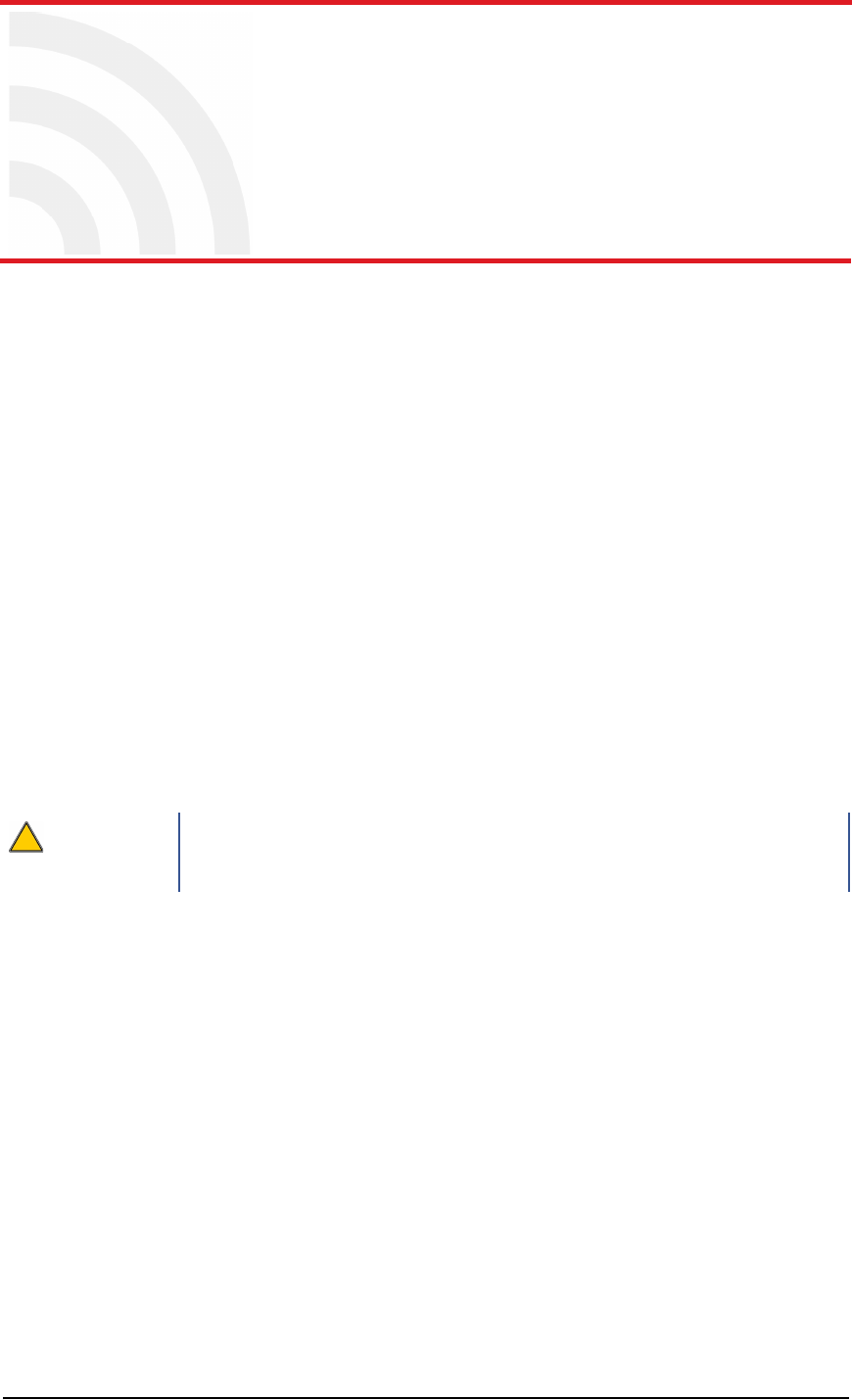
Draft
RT System 2 v2.0.0 62 Deployment Guide R00.e
© 2010-2012 Wireless Seismic, Inc. All rights reserved.
6
6. Troubleshooting and Tips
6.1 Best Practices
This section provides some tips on working with the equipment.
6.1.1 24 Ah Batteries
In order to maintain the best possible communication channel, observe the
following tips:
Place a fully charged 24 Ah battery on the backhaul every day.
Keep extra 24 Ah batteries charged up at the staging area.
Store 24 Ah batteries at the staging area when not in use. Deep
discharging of the batteries can shorten their lifespan considerably.
6.1.2 LIU
When temperature swings are extreme, or weather is severe, store the LIU
boxes in the recording truck at night.
6.1.3 Urban Environments
The following could impact your configuration in urban environments:
You may need to use repeaters when crossing a road.
You may need to extend the antenna with coaxial cable
You may need to adjust WRU placement and antenna strength when
crossing a road.
You will need to consider the presence of power lines and buildings when
placing WRUs and backhaul components.
6.1.4 Ethernet Cables
Use CAT6 enhanced quality cables.
CAUTION
Do not allow the LIU battery to remain connected at a voltage of 22V or
less. Damage to the equipment could occur.

Draft
R00.e RT System 2 v2.0.0 Deployment Guide 63
© 2010-2012 Wireless Seismic, Inc. All rights reserved.
6. Troubleshooting and Tips
Best Practices
6.1.5 Fiber Optic Cables
The fiber optic cables have an environmentally-sealed connector. See the following
figure for an illustration of how the connectors work:
6.1.6 Antennas
When placing or selecting antennas in, consider the following:
Figure 6–1 Fiber Optic Cable Connector

Draft
64 RT System 2 v2.0.0 Deployment Guide R00.e
© 2010-2012 Wireless Seismic, Inc. All rights reserved.
6. Troubleshooting and Tips
Troubleshooting
In areas where there is a steep inclination, smaller gain antennas may provide
a better signal.
In areas where there is a steep inclination, try to reduce the inclination by
going up or down at an angle rather than straight up or down.
Use repeaters to cover overpass and steep inclination situations.
If you need more signal strength, use an extender with a riser to elevate the
antenna. This is the typical scenario with the LIU at the backhaul location.
6.2 Troubleshooting
TBD
6.2.1 Backhaul Troubleshooting Flow
This document shows the recommended steps to use when troubleshooting the
backhaul.
Indications that there are issues with the backhaul communication include the
following:
Missing pings
Dropped line with a red arrow indicating the point of lost communication
LIU unformed
The following figures illustrate the recommended process flow when
troubleshooting backhaul communication issues:
6.2.2 Fluidmesh Radios
TBD
TBD
Figure 6–2 Troubleshooting – Check LIU
TBD
Figure 6–3 Troubleshooting – Check Fluidmesh Radios

Draft
R00.e RT System 2 v2.0.0 Deployment Guide 65
© 2010-2012 Wireless Seismic, Inc. All rights reserved.
6. Troubleshooting and Tips
Troubleshooting
Table 6–1 Troubleshooting Fluidmesh Radios
Problem Solutions
Not communicating • Try sending a ping command in a CMD window to the IP address of the
radio.
• If you are trying to connect directly with a computer, make sure you
have configured a private network (see “Create a Private Network” on
page 38).
• Ensure that you have configured the radios as follows:
- FM1100 = mesh POINT (remote backhaul)
- FM3100 = mesh END (central backhaul)
Cannot access GUI If you configure two FM1100 radios on the same mast to be a mesh POINT
and a mesh END, they will communicate over the switch and lock
everything else out of the communication loop. They must both be
configured as mesh POINTs
GUI not responding It takes one full minute to see the alignment statistics in the Fluidmesh GUI
(from the browser), so be sure to wait for it.

Draft
RT System 2 v2.0.0 66 Deployment Guide R00.e
© 2010-2012 Wireless Seismic, Inc. All rights reserved.
7
7. Batteries
This chapter provides information about the batteries and battery
requirements used in the Wireless Seismic, Inc. RT System 2.
7.1 Lithium Ion Batteries
This section provides information regarding the characteristics, use, and
handling of lithium ion batteries. See the following sections for details:
●“Specifications” on page 66
●“Handling and Safety Guidelines” on page 67
●“Transportation” on page 68
●“Storage” on page 69
7.1.1 Specifications
The RT System 2 uses one or two custom intelligent lithium-ion batteries with
self-contained charging circuitry that protects the batteries from overcharge,
discharge, short circuits, or extreme temperature charging.
Battery specifications are shown in the following table:
Table 7–1 Lithium Ion Battery Specifications
Item Description Value
Voltage Nominal 3.7 VDC
Shut-off 2.8 VDC
Full (90%) charge 4.1 VDC
Overcharge Voltage 4.28 VDC
Over Discharge Voltage 2.80 VDC
Current Maximum Charge Current 2 A
Consumption Active Mode 4.2 mA maximum
Consumption Sleep Mode 66 A maximum
Full (90%) charge
mAh Approximately 12,000
mAh at nominal voltage —
Full (90%) charge
mWh Approximately 44,400
mWh at nominal voltage —

Draft
R00.e RT System 2 v2.0.0 Deployment Guide 67
© 2010-2012 Wireless Seismic, Inc. All rights reserved.
7. Batteries
Lithium Ion Batteries
7.1.2 Handling and Safety Guidelines
Observe the following handling and safety guidelines:
If a battery pack has leaking fluids, do not touch any fluids. Dispose of a
leaking battery pack. In case of eye contact with fluid, do not rub eyes.
Immediately flush eyes thoroughly with water for at least 15 minutes, lifting
upper and lower lids until no evidence of the fluid remains. Seek medical
attention.
Do not disassemble, crush, or puncture a battery
Do not short the external contacts on a battery
Do not dispose of a battery in fire or water
Do not expose a battery to temperatures above 60 °C (140 °F)
Keep the battery away from children
Avoid exposing the battery to excessive shock or vibration
Do not use a damaged battery
Lithium Ion battery packs MUST be completely discharged before disposal
Although there may be local or state restrictions, lithium ion batteries are
considered by the Federal Government as “non-hazardous universal waste”.
There are restrictions for large quantity handlers of universal waste that define
Capacity 48.8 Watt hours
Connector 5-pin —
LED One LED that indicates
charging status when
connected to the charging
station as follows
• Green – Charged
•Red – Charging
• Amber – Transitional
phase between
charging and charged,
or charge temperature
limits exceeded
Label One bar code serial
number label —
Temperature Operating From -40°C to +85°C
Charging From -5°Cto+45°C
Ambient Storage • From -20°C to +45°C
for a maximum period
of one month
• From -20°C to +35°C
for a maximum of 6
months, after which
time the battery packs
will need to be
recharged to above
50% capacity
Table 7–1 Lithium Ion Battery Specifications (cont.)
Item Description Value

Draft
68 RT System 2 v2.0.0 Deployment Guide R00.e
© 2010-2012 Wireless Seismic, Inc. All rights reserved.
7. Batteries
Lithium Ion Batteries
labeling, containment, and so on. Whenever possible the batteries must be
discharged before disposal. Battery leads/contacts should be taped off to
prevent accidental shorting. Each battery pack should be placed in a plastic
bag.
Recycling is encouraged when practical and applicable. The batteries contain
recyclable material and are accepted by several battery recycling companies.
Refer to one of the following for more information on recycling and disposal:
●http://www.swe.com
●http://www.rbrc.org
●http://www.call2recycle.org
●1-800-8-BATTERY
●1-877-2-RECYCLE
7.1.3 Transportation
In the United States, large lithium ion battery shipments (more than 24 cells or 12
batteries per package) are regulated as hazardous material (Class 9) by the
Federal Government and are subject to the regulations described in the following:
Code of Federal Regulations, Title 49 Transportation.
http://ecfr.gpoaccess.gov/cgi/t/text/text-
idx?sid=92868a82add6feba6afa796572133179&c=ecfr&tpl=/ecfrbrowse/
Title49/49tab_02.tpl
International Air Transport Association (IATA)
http://www.iata.org/whatwedo/cargo/dangerous_goods/pages/
lithium_batteries.aspx
Batteries can be ground shipped only if all of the following conditions are met:
Box used meets the 1.2 m drop test box (“UN” rated box) for packaging
Battery pack terminals are protected to prevent a short circuit
Gross weight does not exceed 30 kg (66 pounds)
Outer package is labeled with the current required label. An example is shown
in the following figure.

Draft
R00.e RT System 2 v2.0.0 Deployment Guide 69
© 2010-2012 Wireless Seismic, Inc. All rights reserved.
7. Batteries
Lithium Ion Batteries
Batteries can be air shipped only if all of the following conditions are met:
Box used meets the 1.2 m drop test box (“UN” rated box) for packaging
Maximum weight of each package does not exceed 10 kg (22 lbs)
Battery pack terminals are protected to prevent a short circuit
Outer package is labeled with the current required label. An example is shown
in the previous figure (“Example Battery Shipping Label” on page 69).
7.1.4 Storage
Proper storage and maintenance of Lithium Ion batteries is essential to maximize
their useful life and avoid catastrophic failure. Observe the following storage
precautions:
Figure 7–1 Example Battery Shipping Label
WARNING
The information contained in this document is intended to provide
general awareness of battery regulations; it is not comprehensive, and
the requirements referenced herein may have changed. Nothing in this
chapter or the Deployment Guide constitutes legal advice or is intended
to address any specific legal, compliance, or regulatory issues that may
arise in particular circumstances. This chapter and the Deployment
Guide are not intended to replace current, official regulations regarding
the packaging and shipment of hazardous materials or independent
legal counsel on these issues. You are solely responsible for compliance
with all applicable laws, regulations, and other requirements. Please
refer to an official copy of the current version of these documents for
the latest information.

Draft
70 RT System 2 v2.0.0 Deployment Guide R00.e
© 2010-2012 Wireless Seismic, Inc. All rights reserved.
7. Batteries
Charging Lithium Ion Batteries
Remove the batteries from the WRU for storage
The recommended storage temperature for Lithium ion batteries is as follows:
●From -20°C to +45°C for a maximum period of one month
●From -20°C to +35°C for a maximum of 6 months, after which time the
battery packs will need to be recharged to above 50% capacity
●Storing at cooler temperatures slows down self discharge and capacity loss
over time. Store the batteries at 25°C or less if possible
The recommended storage charge levels are as follows:
●Charge (or discharge) batteries to a 30% to 50% charge level before
placing into storage. Higher or lower charge levels can reduce the battery
life.
●Never store the battery completely depleted of charge unless for disposal.
●Periodic charging is necessary to maintain 30% to 50% charge when stored
for a long period of time
Store batteries in a well ventilated area
Do not leave batteries unused for extended periods of time, either in the
product or in storage. When a battery has been unused for 6 months, check
the charge status and charge or dispose of the battery as appropriate.
Routinely check the battery’s charge status
Consider replacing the battery with a new one if you note either of the
following conditions:
●The battery run time drops below about 80% of the original run time
●The battery charge time increases significantly
7.2 Charging Lithium Ion Batteries
This section describes charging precautions and provides an overview of the
battery charger.
7.2.1 Charging Precautions
Observe the following charging precautions:
Prior to charging, inspect the battery for any visible damage to the case or
connector that could create an electrical shortage.
The temperature range over which the battery can be charged is -5°Cto+45°C.
Charging the battery outside of this temperature can cause the battery to
become hot or to break.
Be absolutely sure that only a 5 V source is used when charging the battery.
Care should be taken to charge batteries on a fireproof surface.
Do not charge batteries near flammable items or liquids.
Keep a Class C Dry Chemical fire extinguisher nearby.
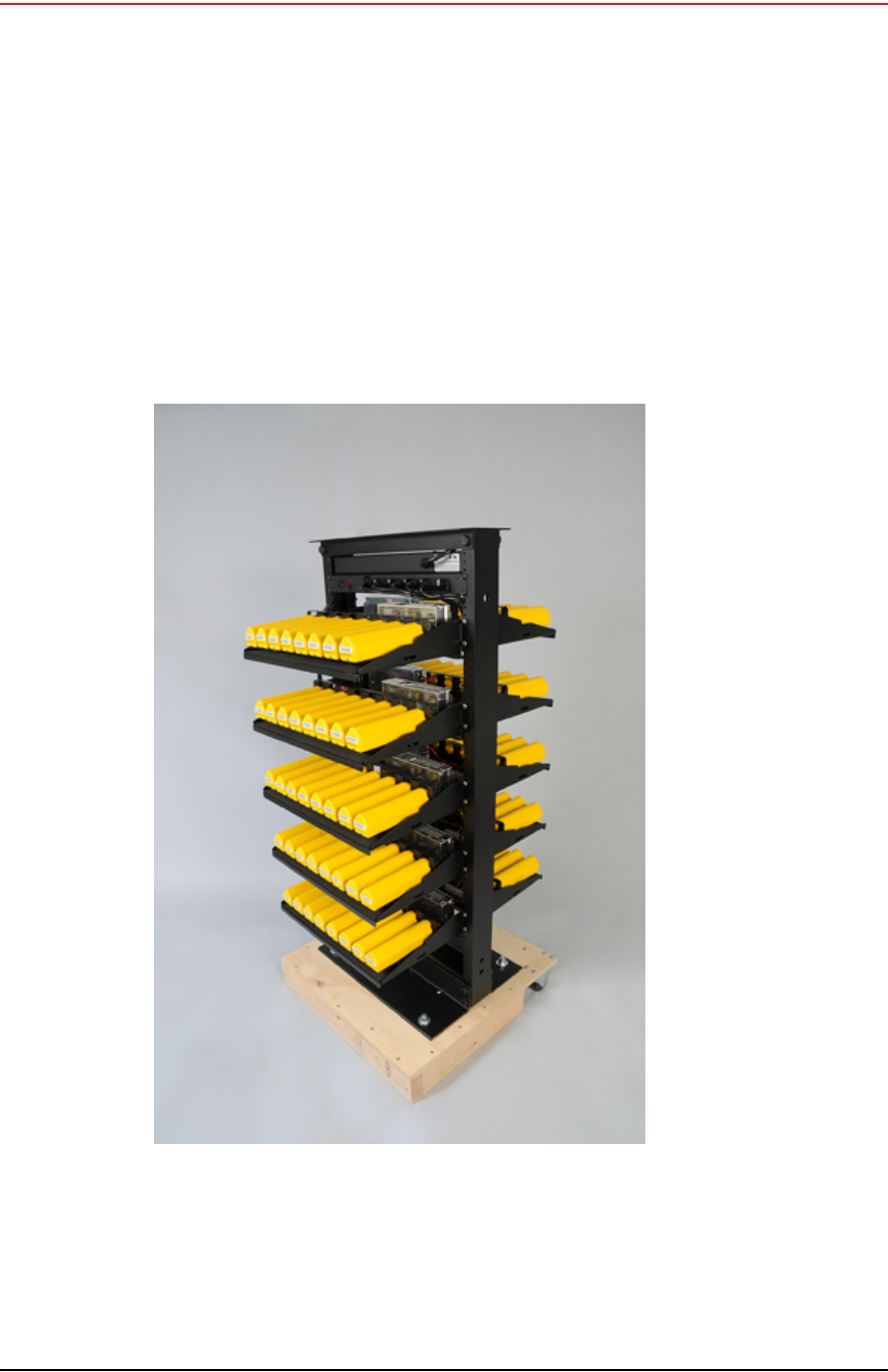
Draft
R00.e RT System 2 v2.0.0 Deployment Guide 71
© 2010-2012 Wireless Seismic, Inc. All rights reserved.
7. Batteries
Charging Lithium Ion Batteries
Do not continue recharging the battery if it does not recharge within the
specified charging time.
A lithium ion battery should NEVER be left unattended while charging.
7.2.2 Battery Charger
The lithium ion battery charger is designed to operate from a single 10 A, 120 VAC
service line.
The power supply to charge the battery pack is a 5VDC regulated voltage supply.
Figure 7–2 Battery Charger

Draft
72 RT System 2 v2.0.0 Deployment Guide R00.e
© 2010-2012 Wireless Seismic, Inc. All rights reserved.
7. Batteries
LIU Battery
7.3 LIU Battery
TBD
Figure 7–3 Serial Number
Label and LED Indicator

Draft
RT System 2 v2.0.0 73 Deployment Guide R00.e
© 2010-2012 Wireless Seismic, Inc. All rights reserved.
8
8. Batteries
Ce chapitre fournit des informations sur les batteries utilisées dans le système
RT System 2 de Wireless Seismic, Inc.
8.1 Batteries au lithium-ion
Cette section fournit des informations sur les caractéristiques, l'utilisation et la
manipulation des batteries au lithium-ion. Reportez-vous aux sections
suivantes pour en savoir plus:
●“Spécifications” on page 73
●“Directives en matière de manipulation et de sécurité” on page 74
●“Transport” on page 75
●“Entreposage” on page 77
8.1.1 Spécifications
Le RT System 2 utilise une ou deux batteries au lithium-ion intelligentes et
personnalisées, dotées d'un circuit de charge autonome qui protège les
batteries contre les surcharges, décharges, courts-circuits ou changements
extrêmes de température.
Le tableau suivant indique les spécifications des batteries:
Tableau 8–1 Spécifications des batteries au lithium-ion
Élément Description Valeur
Tension Nominale 3,7 V c.c.
Arrêt 2,8 V c.c.
Charge complète (90 %) 4,1 V c.c.
Tension de surcharge 4,28 V c.c.
Les surtensions de
décharge 2,80 V c.c.
Courant Courant de charge
maximum 2 A
Mode de consommation
active 4,2 mA maximum
Mode veille la
consommation 66 A maximum

Draft
74 RT System 2 v2.0.0 Deployment Guide R00.e
© 2010-2012 Wireless Seismic, Inc. All rights reserved.
8. Batteries
Batteries au lithium-ion
8.1.2 Directives en matière de manipulation et de
sécurité
Respecter les directives suivantes en matière de manipulation et de sécurité :
Si un bloc-batterie présente une fuite de liquides, ne pas toucher les liquides.
Jeter le bloc-batterie en cas de fuite. En cas de contact oculaire avec du liquide,
ne pas se frotter les yeux. Rincer immédiatement les yeux avec de l'eau
pendant au moins 15 minutes, en soulevant les paupières supérieures et
inférieures jusqu'à ce qu'il n'y ait plus de trace de liquide. Consulter un
médecin.
Ne pas démonter, écraser ou percer une batterie
Ne pas court-circuiter les contacts externes d'une batterie
Ne pas jeter une batterie dans le feu ou l'eau
Charge complète (90
%) mAh Environ 12 000 mAh à la
tension nominale
Charge complète (90
%) mWh Environ 44 400 mWh à la
tension nominale
Connecteur 5 broches
DEL Une DEL qui indique l'état
de charge lors de la
connexion à la station de
charge, de la manière
suivante :
•Vert : chargé
• Rouge : en train de
charger
• Orange : phase
transitionnelle entre
l'état de chargement
et l'état chargé, ou
dépassement des
limites de la
température de
charge
Étiquette Une étiquette indiquant le
numéro de série sous
forme de code à barres
Température Fonctionnement De -40°C à +85°C
Chargement De -5°Cà+45°C
Entreposage à
température ambiente • De -20°C à +45°C
durant une période
maximum d'un mois
• De -20°C à +35°C
durant 6 mois
maximum ; passé ce
délai, les blocs-
batteries doivent être
rechargés à plus de
50 % de leur capacité
Tableau 8–1 Spécifications des batteries au lithium-ion (cont.)
Élément Description Valeur

Draft
R00.e RT System 2 v2.0.0 Deployment Guide 75
© 2010-2012 Wireless Seismic, Inc. All rights reserved.
8. Batteries
Batteries au lithium-ion
Ne pas exposer une batterie à des températures supérieures à 60 °C (140 °F)
Maintenir la batterie à l'écart des enfants
Éviter d'exposer la batterie à des vibrations ou chocs excessifs
Ne pas utiliser une batterie endommagée
Les blocs-batteries au lithium-ion DOIVENT être entièrement déchargés avant
leur élimination
Bien qu'il puisse exister des restrictions locales ou nationales, les batteries au
lithium-ion sont considérées comme des « déchets universels non dangereux »
par le gouvernement fédéral. Il existe des restrictions qui s'appliquent à ceux
qui gèrent de grandes quantités de déchets universels ; celles-ci définissent
l'étiquetage, le confinement, etc. Dans la mesure du possible, les batteries
doivent être déchargées avant de les jeter. Les conducteurs/contacts de
batterie doivent être fixés de manière à éviter un court-circuit accidentel.
Chaque bloc-batterie doit être placé dans un sac en plastique.
Le recyclage est encouragé lorsqu'il est réalisable. Les batteries contiennent
des matériaux recyclables et sont acceptées par plusieurs entreprises de
recyclage de batteries. Reportez-vous à l'un des éléments suivants pour obtenir
plus d'informations sur le recyclage et l'élimination :
●http://www.swe.com
●http://www.rbrc.org
●http://www.call2recycle.org
●1-800-8-BATTERY
●1-877-2-RECYCLE
8.1.3 Transport
Aux États-Unis, les expéditions de grandes quantités de batterie au lithium-ion
(plus de 24 piles ou 12 batteries par colis) sont réglementées comme des matières
dangereuses (classe 9) par le gouvernement fédéral et sont soumises aux
règlements décrits ci-après :
Code of Federal Regulations, Title 49 Transportation.
http://ecfr.gpoaccess.gov/cgi/t/text/text-
idx?sid=92868a82add6feba6afa796572133179&c=ecfr&tpl=/ecfrbrowse/
Title49/49tab_02.tpl
International Air Transport Association (IATA)
http://www.iata.org/whatwedo/cargo/dangerous_goods/pages/
lithium_batteries.aspx
Les batteries ne peuvent être expédiées par voie terrestre que si toutes les
conditions suivantes sont satisfaites :
La boîte utilisée satisfait le test de chute de 1,2 m (boîte classée « UN ») de
boîte d'emballage
Les bornes de bloc-batterie sont protégées pour éviter un court-circuit
Le poids brut ne dépasse pas 30 kg (66 livres)
L'emballage extérieur porte l'étiquette requise en vigueur. La figure suivante en
montre un exemple.

Draft
76 RT System 2 v2.0.0 Deployment Guide R00.e
© 2010-2012 Wireless Seismic, Inc. All rights reserved.
8. Batteries
Batteries au lithium-ion
Les batteries ne peuvent être expédiées par voie aérienne que si toutes les
conditions suivantes sont satisfaites :
La boîte utilisée satisfait le test de chute de 1,2 m (boîte classée « UN ») de
boîte d'emballage
Les bornes de bloc-batterie sont protégées pour éviter un court-circuit
Le poids brut de chaque colis ne dépasse pas 10 kg (22 livres)
L'emballage extérieur porte l'étiquette requise en vigueur. La figure précédente
en montre un exemple (“Example Battery Shipping Label” on page 76).
Exemple 8–1 Example Battery Shipping Label

Draft
R00.e RT System 2 v2.0.0 Deployment Guide 77
© 2010-2012 Wireless Seismic, Inc. All rights reserved.
8. Batteries
Batteries au lithium-ion
8.1.4 Entreposage
Un entreposage et un entretien adéquats des batteries au lithium-ion est
indispensable pour optimiser leur durée de vie utile et éviter une défaillance
catastrophique. Respecter les précautions suivantes en matière d'entreposage :
Retirer les batteries de l'unité distante sans fil avant l'entreposage
Température d'entreposage recommandée des batteries au lithium-ion :
●De -20°C à +45°C durant une période maximum d'un mois
●De -20°C à +35°C durant 6 mois maximum ; passé ce délai, les blocs-
batteries doivent être rechargés à plus de 50 % de leur capacité
●L'entreposage à basses températures ralentit la décharge naturelle et la
perte de capacité au fil du temps. Entreposer les batteries à 25°C ou moins
si possible
Niveaux de charge d'entreposage recommandés :
●Charger (ou décharger) les batteries à un niveau de charge de 30 % à
50 % avant de les entreposer. Des niveaux de charge inférieurs ou
supérieurs peuvent réduire la durée de vie des batteries.
●Ne jamais entreposer des batteries entièrement déchargées, sauf en cas
d'élimination.
●Un chargement périodique est nécessaire pour maintenir une charge de
30 % à 50 % en cas d'entreposage de longue durée
Entreposer les batteries dans un endroit bien aéré
Ne pas laisser les batteries inutilisées pendant de longues durées, qu'elles
soient dans le produit ou placées en entreposage. Si une batterie n'a pas été
utilisée pendant 6 mois, vérifier l'état de charge et charger ou éliminer la
batterie, le cas échéant.
AVERTISSEMENT
Les informations contenues dans le présent document
ont pour but de fournir une connaissance générale des
règlements s'appliquant aux batteries. Elles ne sont pas
exhaustives, et les conditions mentionnées dans ce
document peuvent avoir changées. Rien dans le présent
chapitre ou dans le Guide de déploiement ne constitue
un avis juridique ou est destiné à répondre aux
problèmes juridiques, de conformité, ou réglementaires
spécifiques qui peuvent survenir dans des circonstances
particulières. Le présent chapitre et le Guide de
déploiement ne sont pas destinés à remplacer les
règlements officiels en vigueur concernant l'emballage
et l'expédition de matières dangereuses ou un conseil
juridique indépendant sur c es questions. Vous êtes
seul responsable du respect de toutes les lois,
règlements et autres exigences. Veuillez vous reporter à
une copie officielle de la version en vigueur de ces
documents pour obtenir les dernières informations.

Draft
78 RT System 2 v2.0.0 Deployment Guide R00.e
© 2010-2012 Wireless Seismic, Inc. All rights reserved.
8. Batteries
Chargement des batteries au lithium-ion
Vérifier régulièrement l'état de charge de la batterie
Envisager le remplacement de la batterie par une nouvelle en cas de constat
d'une des conditions suivantes :
●L'autonomie de la batterie descend en dessous d'environ 80 % de son
autonomie initiale
●Le temps de charge de la batterie augmente sensiblement
8.2 Chargement des batteries au lithium-ion
Cette section décrit les précautions de chargement et présente le chargeur de
batterie.
8.2.1 Précautions de chargement
Respecter les précautions de chargement suivantes :
Avant de la charger, inspecter la batterie pour détecter les signes éventuels de
dommages sur le boîtier ou les connecteurs susceptibles de créer un court-
circuit.
La batterie peut être chargée dans la plage de température de -5°Cà+45°C. En
cas de chargement de la batterie en dehors de cette plage, la batterie peut
devenir très chaude ou se rompre.
Être absolument sûr de l'utilisation d'une source de 5 V lors du chargement de
la batterie.
Prendre soin de charger les batteries sur une surface ininflammable.
Ne pas charger les batteries à proximité d'objets ou de liquides inflammables.
Conserver un extincteur à poudre chimique de classe C à proximité.
Ne pas continuer de recharger la batterie si elle ne se recharge pas dans le
temps de chargement spécifié.
NE JAMAIS laisser une batterie au lithium-ion sans surveillance lorsqu'elle est
en train de charger.
8.2.2 Chargeur de batterie
Le chargeur de batterie au lithium-ion est conçu pour fonctionner à partir d'une
ligne de service simple 120 V c.a., 10 A.
Le bloc d'alimentation servant à charger le bloc-batterie fournit une tension
régulée de 5 V c.c.

Draft
R00.e RT System 2 v2.0.0 Deployment Guide 79
© 2010-2012 Wireless Seismic, Inc. All rights reserved.
8. Batteries
Chargement des batteries au lithium-ion
Exemple 8–2 Chargeur de batterie

Draft
80 RT System 2 v2.0.0 Deployment Guide R00.e
© 2010-2012 Wireless Seismic, Inc. All rights reserved.
8. Batteries
LIU de batterie
8.3 LIU de batterie
TBD
Exemple 8–3 Étiquette avec
numéro de série et voyant
DEL

Draft
RT System 2 v2.0.0 81 Deployment Guide R00.e
© 2010-2012 Wireless Seismic, Inc. All rights reserved.
A
A. Legal Information
A.1 FCC Rules and Regulations Compliance
The Federal Communications Commission (FCC) regulates the use of antennas
in the “Code of Federal Regulations – Title 47, Part 15 – Radio Frequency
Devices, Subpart C – Intentional Radiators, Section 15.203 Antenna
Requirement.”
When used as intended, the RT System 2 complies with FCC Section 15.203
requirements as follows:
The RT System 2 antennas shall be installed and handled by professionals
specifically designated for this purpose.
Changes or modifications not expressly approved by Wireless Seismic, Inc.
can void the users’s authority to operate the equipment.
The RT System 2 shall be used with only the supplied antennas (Table A–1)
attached to the WRU or LIU with an integrated type N male connector.
NOTE
This equipment has been tested and found to comply with the limits for
a Class A digital device, pursuant to part 15 of the FCC Rules. These
limits are designed to provide reasonable protection against harmful
interference when the equipment is operated in a commercial
environment. This equipment generates, uses, and can radiate radio
frequency energy and, if not installed and used in accordance with the
instruction manual, may cause harmful interference to radio
communications. Operation of this equipment in a residential area is
likely to cause harmful interference in which case the user will be
required to correct the interference at his own expense.
Table A–1 Antenna Specifications
Model Frequency
(MHz) Gain Vertical
Bandwidth Weight Dimension
(Length x
Diameter)
WSI 65-0067 2400-2485 9 dbi 14° 0.8 lbs
0.5 kg 27 x 0.6 in
690 x 15 mm
WSI 6060-001-01 2400-2485 7 dBi 18° 0.6 lbs
0.3 kg 21 x 0.6 in
540 x 15 mm
WSI 65-0023 2400-2485 5 dBi 25º 0.5 lbs
0.2 kg 12 x 0.6 in
355 x 15 mm
WSI 65-0025 2400-2485 2 dBi @ 2.4 120° 1.6 oz
45.4 g 7.6 x 0.5 in
193 x 12.7 mm

Draft
82 RT System 2 v2.0.0 Deployment Guide R00.e
© 2010-2012 Wireless Seismic, Inc. All rights reserved.
A. Legal Information
Industry Canada Compliance
FCC equipment authorization has been granted as follows:
The 5Mbps Line Interface Unit has been granted FCC equipment authorization
under the FCC Identifier YZO-00600.
The 5Mbps Wireless Remote Unit has been granted FCC equipment
authorization under the FCC Identifier YZO-00103.
A.2 Industry Canada Compliance
The Wireless Remote Unit has been granted Industry Canada (IC) approval and
certification per RSS-210 Issue8 and RSS-102 Issue 4 as:
5Mbps WRU:
●Model number 10-0017
●IC: 10081A-WSI00103
The Line Interface Unit (LIU) has been granted Industry Canada (IC) approval and
certification per RSS-210 Issue 8 and RSS-102 Issue 4 as:
5Mbps LIU:
●Model Number 10-0016
●IC: 10081A-WSI00600
WSI 65-0082 2400-2485 7.4 dBi 20º 5.4 oz
153 g 18.5 x 0.75 in
470 x 19 mm
WSI 65-0131 2400-2485 4 dBi 50º 3.2 oz
90 g 8.7 x 0.75 in
221 x 19 mm
Table A–1 Antenna Specifications (cont.)
Model Frequency
(MHz) Gain Vertical
Bandwidth Weight Dimension
(Length x
Diameter)
WARNING
In order to comply with FCC radio frequency (RF) exposure
requirements, the RT System 2 units must be installed so that a
minimum separation distance of 20 cm is maintained between the
antenna(s) and the body of all persons at all times during normal
operation.
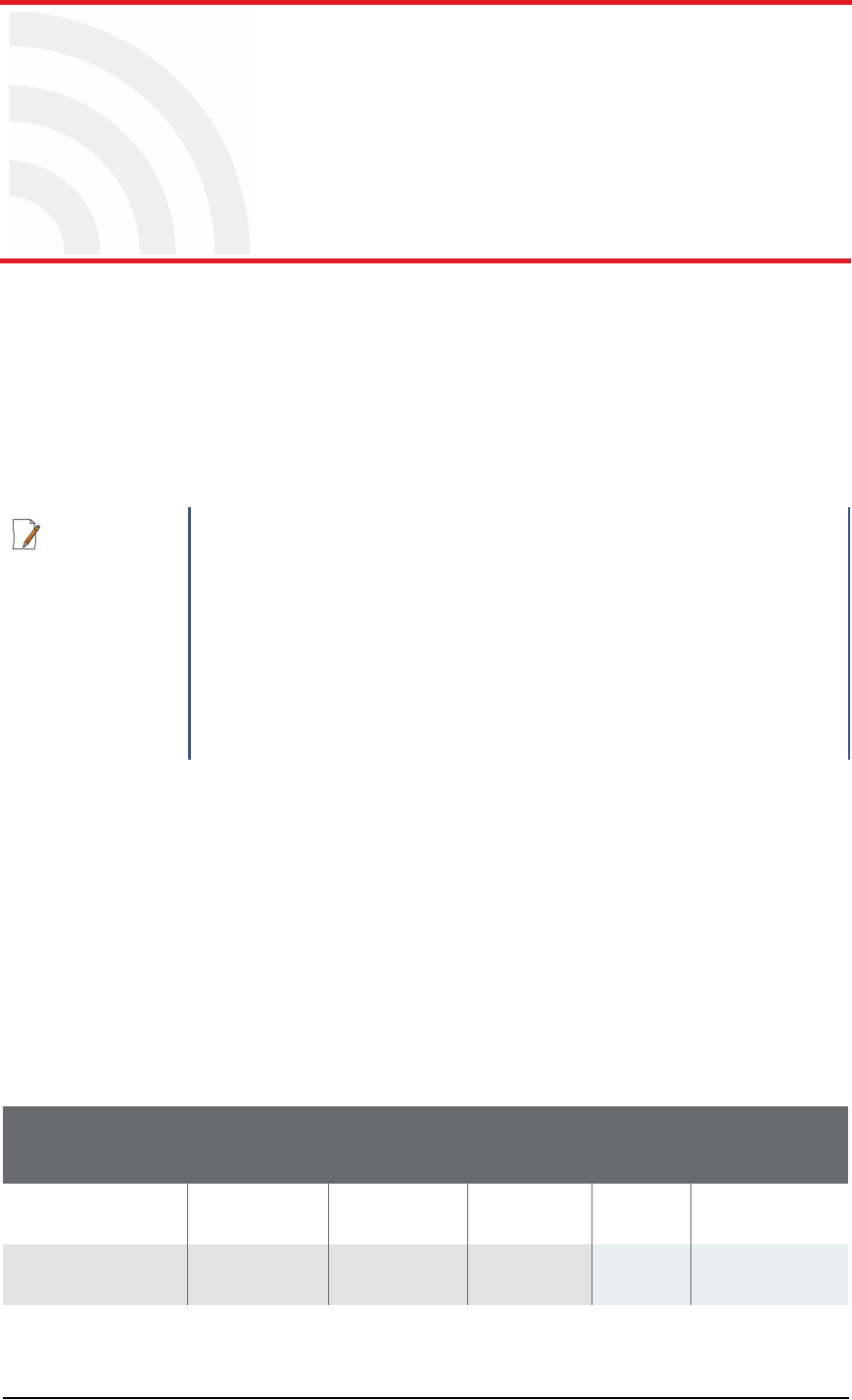
Draft
RT System 2 v2.0.0 83 Deployment Guide R00.e
© 2010-2012 Wireless Seismic, Inc. All rights reserved.
B
B. l'information juridique
B.1 Conformité avec les règles et règlements de la
FCC
La Federal Communications Commission (FCC) règlemente l'utilisation
d'antennes dans l'article suivant : Code of Federal Regulations – Title 47, Part
15 – Radio Frequency Devices, Subpart C – Intentional Radiators, Section
15.203 Antenna Requirement.
Lorsqu'il est utilisé comme prévu, le RT System 2 respecte les conditions de
l'article 15.203 de la FCC de la manière suivante :
Les antennes du RT System 2 doivent être installées et manipulées par des
professionnels spécifiquement désignés pour cela.
Les changements ou modifications non expressément approuvés par
Wireless Seismic, Inc. peuvent annuler l'autorisation de l'utilisateur
d'utiliser l'équipement.
Le RT System 2 doit être utilisé uniquement avec les antennes fournies
(Tableau B–1) branchées à l'unité distante sans fil ou à la station de base à
l'aide d'un connecteur mâle de type N intégré.
REMARQUE
Cet équipement a été testé et jugé conforme aux limites fixées pour
un appareil numérique de classe A, conformément à la partie 15 des
règles de la FCC. Ces limites sont conçues pour fournir une protection
raisonnable contre les interférences nuisibles lorsque l'équipement est
utilisé dans un environnement commercial. Cet équipement génère,
utilise et peut émettre l'énergie des fréquences radio et, s'il n'est pas
installé et utilisé conformément au mode d'emploi, peut causer des
interférences nuisibles avec les communications radio. Le
fonctionnement de cet équipement dans une zone résidentielle est
susceptible de provoquer des interférences nuisibles, auquel cas
l'utilisateur devra corriger les interférences à ses propres frais.
Tableau B–1 Spécifications des antennes
Modèle Fréquence
(MHz) Gain Largeur
de bande
verticale Poids Dimensions
(Longueur x
Diamètre)
WSI 65-0067 2400-2485 9 dbi 14° 0,8 lb
0,5 kg 27 x 0,6 po
690 x 15 mm
WSI 6060-001-01 2400-2485 7 dBi 18° 0,6 lb
0,3 kg 21 x 0,6 po
540 x 15 mm

Draft
84 RT System 2 v2.0.0 Deployment Guide R00.e
© 2010-2012 Wireless Seismic, Inc. All rights reserved.
B. l'information juridique
Industrie Canada Conformité
L'autorisation d'équipement de FCC a été accordée comme suit :
Le 5Mbps unité d'interface de ligne a reçu l'autorisation d'équipement de la FCC
sous l'identifiant YZO-00600.
Le 5Mbps unité lointaine sans fil a reçu l'autorisation d'équipement de la FCC
sous l'identifiant YZO-00103.
B.2 Industrie Canada Conformité
L'unité distante sans fil a reçu l'approbation et la certification d'Industrie Canada
(IC) par rapport à CNR-210 8e édition et CNR-102 4e édition :
5Mbps WRU
●Numéro de modèle : 10-0017
●Numéro de certification IC : IC: 10081A-WSI00103
L'unité d'interface de ligne a reçu l'approbation et la certification d'Industrie
Canada (IC) par rapport à CNR-210 8e édition et CNR-102 4e édition :
5Mbps LIU
●Numéro de modèle : 10-0016
●Numéro de certification IC : IC: 10081A-WSI00600
WSI 65-0023 2400-2485 5 dBi 25º 0,5 lb
0,2 kg 12 x 0,6 po
355 x 15 mm
WSI 65-0025 2400-2485 2 dBi à 2,4 120° 1,6 oz
45,4 g 7.6 x 0,5 po
193 x 12,7 mm
WSI 65-0082 2400-2485 7,4 dBi 20º 5,4 oz
153 g 18,5 x 0,75 in
470 x 19 mm
WSI 65-0131 2400-2485 4 dBi 50º 3,2 oz
90 g 8,7 x 0,75 in
221 x 19 mm
Tableau B–1 Spécifications des antennes (cont.)
Modèle Fréquence
(MHz) Gain Largeur
de bande
verticale Poids Dimensions
(Longueur x
Diamètre)
AVERTISSEMENT
Afin de se conformer aux normes de la FCC en matière d'exposition
aux radiofréquences (RF), les unités RT System 2 doivent être
installées de manière à garder en permanence une distance
minimale de 20 cm entre la ou les antennes et le corps de toute
personne en mode de fonctionnement normal.

Draft
RT System 2 v2.0.0 85 Deployment Guide R00.e
© 2010-2012 Wireless Seismic, Inc. All rights reserved.
C
C. Fluidmesh Radio Specifications
The information in this chapter is reproduced here for your convenience from
the Fluidmesh data sheet available at the following location:
http://www.fluidmesh.com/press-room/product-literature/doc_details/160-
fluidmesh-mito-series
© 2005-2010 Fluidmesh Networks, Inc. (90-0012)
C.1 The Fluidmesh Mito Series
The Fluidmesh® MITO Series is a MIMO-based tri-band wireless Ethernet
product line designed and manufactured specifically for multi-service backhaul
applications.
MITO - The Revolution in Wireless Backhauling
With the MITO product line, Fluidmesh has developed a revolutionary wireless
backhaul solution that is capable of offering extreme performances with a
small form factor. MITO is a unique 2x2 MIMO solution with integrated
directional antennas which has allowed Fluidmesh to break the mould and
create a product line that is a game changer in the wireless backhauling arena.
You won't need to install external antennas. You won't need to deal with
coaxial cables, lighting suppressors, and grounding. The Fluidmesh
1100 MITO and the Fluidmesh 3100 MITO have an integrated radio-antenna
solution with an outdoor rated enclosure that is slightly bigger than two decks
of cards. The Fluidmesh 11oo MITO mounts a 2x2 MIMO patch antenna and
can be used to create point to point, point to multipoint, and mesh networks
providing unparalleled performances and a compact form factor. The Fluidmesh
3100 MITO mounts a 2x2 MIMO sector antenna and is designed for medium
and large point to multipoint deployments with up to 150 clients.
Tri-band Radio operating at 4.9 GHz, and 5.1-5.8 GHz
The Fluidmesh MITO Series features one tri-band radio and can operate at 4.9
GHz, and 5.1-5.8 GHz and modulate up to 300 Mbps. The preferred frequency
can be easily selected through a web based interface.
Optimized Prodigy Transmission Protocol for maximum Reliability
The Fluidmesh MITO Series employs Prodigy, Fluidmesh's proprietary high
performance 'intelligent' transmission protocol, built to overcome the limits of
standard license-free protocols and to deliver a wireless infrastructure with a
higher level of reliability. Prodigy was developed to transmit any IP-compatible
traffic including data, video, and voice. At the base of our innovative
transmission protocol, there is a traffic optimization algorithm that allows
every Fluidmesh device to assign a specific level of priority and reliability to
every packet transmitted. This process allows the wireless network to
automatically adjust its transmission parameters based on the type of traffic

Draft
86 RT System 2 v2.0.0 Deployment Guide R00.e
© 2010-2012 Wireless Seismic, Inc. All rights reserved.
C. Fluidmesh Radio Specifications
The Fluidmesh Mito Series
transmitted. The overall result is a better, more reliable, multi-service wireless
infrastructure.
Compact Design for Easy Installation
The Fluidmesh MITO Series has a compact form factor designed for low visual
impact deployments. The integrated panel antenna makes for easy installation and
supports a range of up to 30 miles in line of sight. The provided low-power POE
injector guarantees a straight-forward set-up.
FluldThrottle™
The Fluidmesh MITO Series is based on the innovative FluidThrottle™ technology
which allows the user to limit the total cost of ownership of the wireless network
by paying only for the amount of bandwidth required. Additional throughput can be
easily achieved by upgrading the system with software plug-ins in case the
bandwidth requirements increase over time. This solution makes Fluidmesh the
most cost-effective and flexible wireless solution provider in the market.
FluidMAX™
The Fluidmesh MITO Series supports the patent-pending FluidMAX™ technology
and can be used to create Point-to-Point, Point-to-Multipoint, and Mesh
architectures. Thanks to FluidMAX™, the Fluidmesh MITO Series can operate with
a centralized medium access control protocol, or with a distributed medium access
control protocol, depending on the network layout. That means that our units can
operate in either CSMA or TDMA. The decision is made automatically by the
network based on its layout and requires no user intervention.
EasyMesh® Platform and FMQuadro Interface
The Fluidmesh MITO Series includes EasyMesh™. The EasyMesh technology allows
the user to set the same range of private IP addresses across the entire network.
The Fluidmesh MITO Series also includes the FMQuadro™ web interface which
allows the user to configure, monitor, and troubleshoot the wireless network in real
time without the need of additional software or a server. The unit comes with a
built-in spectrum analyzer, a real-time bandwidth monitoring tool, and a wizard to
facilitate the configuration of the system.
AES-128 Encryption Support (FIPS-197 Compliant)
The Fluidmesh MITO Series includes support for 128 bit AES Encryption at the link-
level which can be used for FIPS-197 compliance. Because AES Is Implemented in
hardware, there is no loss in terms of performance when AES is enabled.
Simple Network Management Protocol (SNMP) Support
The Fluidmesh MITO Series supports SNMP version 3. The Simple Network
Management Protocol allows the user to centrally manage the mesh devices with a
SNMP server and to receive automatic alarms in case of network failure.

Draft
R00.e RT System 2 v2.0.0 Deployment Guide 87
© 2010-2012 Wireless Seismic, Inc. All rights reserved.
C. Fluidmesh Radio Specifications
Fluidmesh 1100 with MITO Technology
C.2 Fluidmesh 1100 with MITO Technology
RADIO
ELECTRICAL
ENVIRONMENTAL
PHYSICAL
Frequency Bands: 5.15-5.25 and 5.725-5.825 GHz (US, FCC)
5.470-5.725 GHz (Europe, ETSI)
4.940 - 4.990 GHz (US,FCC)
Modulation: OFDM (BPSK, QPSK, 16-QAM, 64-QAM)
Modulation speed: Up to 300 Mbps
TX Power: Up to 27 dBm, depending on configuration and
regulatory constraints
AX Sensitivity 5GHz: -96d8@6.5Mbps;-75dB@300Mbps
Antenna Type: 2x2 MIMO
Antenna Gain: 14.6-16.1 dBi
Antenna Polarization: Dual Linear
Cross-pol Isolation: 22dB minimum
Max VSWR: 1.6:1
H-pol Beamwidth: 43 deg.
V-pol Beamwidth: 41 deg.
Elevation Beamwidth: 15 deg.
Power input: Passive PoE 15V
DC,
0.8A, (pairs
4,5+;
7,8
return
)
Power
consumption:
Max
8W
Power over E
thernet
Injector:
Included
,
90/260V
50/60 Hz AC
input
Operating Temperature: -30°C to +80°C
Storage Temperature: -30°C to +80°C
Humidity: 95% condensing
Weather Rating: IP65
Wind Survivability: 120 mph
Shock & Vibration: ETSI 300-019-1.4
Interfaces: Two (2) Internal Ethernet
10/100BaseT autosensing, RJ45
Dimensions (mm): 294 (h) X 80 (w) X 30(d)
Weight (Kg): 0.4
Enclosure material: Outdoor UV Stabilized Plastic

Draft
88 RT System 2 v2.0.0 Deployment Guide R00.e
© 2010-2012 Wireless Seismic, Inc. All rights reserved.
C. Fluidmesh Radio Specifications
Fluidmesh 3100 with MITO Technology
OPTIONAL SOFTWARE PLUG-INS
Ethernet Capacity Plug-in up to 1 Mbps (included)
Ethernet Capacity Plug-in up to 2.5 Mbps
Ethernet Capacity Plug-in up to 5 Mbps
Ethernet Capacity Plug-in up to 10 Mbps
Ethernet Capacity Plug-in up to 30 Mbps
Ethernet Capacity Plug-in up to 60 Mbps
Unlimited Wired Ethernet Capacity Plug-in (up to 100 Mbps)
802.1Q VLAN Support
AES-128 Encryption
C.3 Fluidmesh 3100 with MITO Technology
RADIO
ELECTRICAL
ENVIRONMENTAL
Frequency Bands: 5.15-5.25 and 5.725-5.825 GHz (US, FCC)
5.470-5.725 GHz (Europe, ETSI)
4.940 - 4.990 GHz (US,FCC)
Modulation: OFDM (BPSK, QPSK, 16-QAM, 64-QAM)
Modulation speed: Up to 300 Mbps
TX Power: Up to 27 dBm, depending on configuration and
regulatory constraints
AX Sensitivity 5GHz: -96d8@6.5Mbps;-75dB@300Mbps
Antenna Type: 2x2 MIMO
Antenna Gain: 14.6-17.1 dBi
Antenna Polarization: Dual Linear
Cross-pol Isolation: 22dB minimum
Max VSWR: 1.5:1
H-pol Beamwidth: 72 deg.
V-pol Beamwidth: 93 deg.
Elevation Beamwidth: 8 deg.
Power input: Passive PoE 24V
DC,
1A, (pairs
4,5+;
7,8
return
)
Power
consumption:
Max
8W
Power over E
thernet
Injector:
Included
,
90/260V
50/60 Hz AC
input
Operating Temperature: -30°C to +75°C

Draft
R00.e RT System 2 v2.0.0 Deployment Guide 89
© 2010-2012 Wireless Seismic, Inc. All rights reserved.
C. Fluidmesh Radio Specifications
MITO Series General Characteristics
PHYSICAL
OPTIONAL SOFTWARE PLUG-INS
Ethernet Capacity Plug-in up to 10 Mbps
Ethernet Capacity Plug-in up to 30 Mbps
Ethernet Capacity Plug-in up to 60 Mbps
Unlimited Wired Ethernet Capacity Plug-in (up to 100 Mbps)
802.1Q VLAN Support
AES-128 Encryption
C.4 MITO Series General Characteristics
NETWORK
Protocols: UDP, TCP, IP, RTP, RTCP, RTSP, HTIP, HTIPS, ICMP, ARP
Medium Access Control (MAC) Protocols: Centralized Polling-based, Distributed
CSMA/CA-based
Web-based interface for remote management
Multicast support
UPnP support
NMP support
802.1Q VLAN Support
SECURITY
Full VPN compatibility
Full compatibility with all encryption and authentication standards
(AES, 3DES, RSA, HTIPS, SSL, etc.)
AES-128 (FIPS-197 Compliant) Link-level Encryption
APPROVALS
FCC CFR 47 Part 15, class B
Industry Canada RSS 210
Storage Temperature: -30°C to +75°C
Humidity: 95% condensing
Weather Rating: IP65
Wind Survivability: 120 mph
Shock & Vibration: ETSI 300-019-1.4
Interfaces: One (1) Internal Ethernet
10/100BaseT autosensing, RJ45
Dimensions (mm): 370 (h) X 80 (w) X 70(d)
Weight (Kg): 1.6
Enclosure material: Anodized Aluminum

Draft
90 RT System 2 v2.0.0 Deployment Guide R00.e
© 2010-2012 Wireless Seismic, Inc. All rights reserved.
C. Fluidmesh Radio Specifications
MITO Series General Characteristics
CEI!
SUPPLIED ACCESSORIES
PoE Injector with US/EU/UK Power Cord
Pole Mounting Kit (i.e.Pole Mounting Kit Max O.D. 2 in.)
WARRANTY
Two (2) years on parts and labor
Three (3) years optional extended warranty plan with advanced replacement
Five (5) years optional extended warranty plan with advanced replacement
Copyright
©
2005-2010 Fluidmesh Networks, Inc. All rights reserved. Fluidmesh is
a registered trademark of Fluidmesh Networks, Inc. EasyMesh, FMQuadro,
FluidMAX and FluidThrottle are trademarks of Fluidmesh Networks, Inc. All other
brand or product names are the trademarks or registered trademark of their
respective holder(s). Information contained herein is subject to change without
notice. The only warranties for Fluidmesh Networks products and services are set
forth in the express warranty statements accompanying such products and
services. Nothing herein should be construed as constituting an additional
warranty. Fluidmesh Networks shall not be liable lor technical or editorial errors or
omissions contained herein.
Fluidmesh Networks, Inc.
18 Tremont Street, Suite 730
Boston, MA 02108
U.S.A.
Tel. +1 {617) 209-6080
Fax. +1 {866} 458-1522
www.fluidmesh.com
info@fluidmesh.com
EMEA Headquarters {Italy}
Tel. +39.02.0061.6189
UK Branch
Tel. +44.2078.553.132

Draft
RT System 2 v2.0.0 91 Deployment Guide R00.e
© 2010-2012 Wireless Seismic, Inc. All rights reserved.
D
D. LED Indicators
This chapter provides the possible LED status and error indicators for WRUs
and LIUs.
Table D–1 5Mbps WRU Power On Sequence LED Indications
LED Indicators Summary Description
1Hard Reset The LEDs light up in clockwise
rotation starting and ending with the
A battery LED in the following cases:
• When the batteries are attached
• Anytime the unit resets itself
• In between updating firmware
applications
2Check for New
Firmware Solid MODE
Approximately 5 seconds
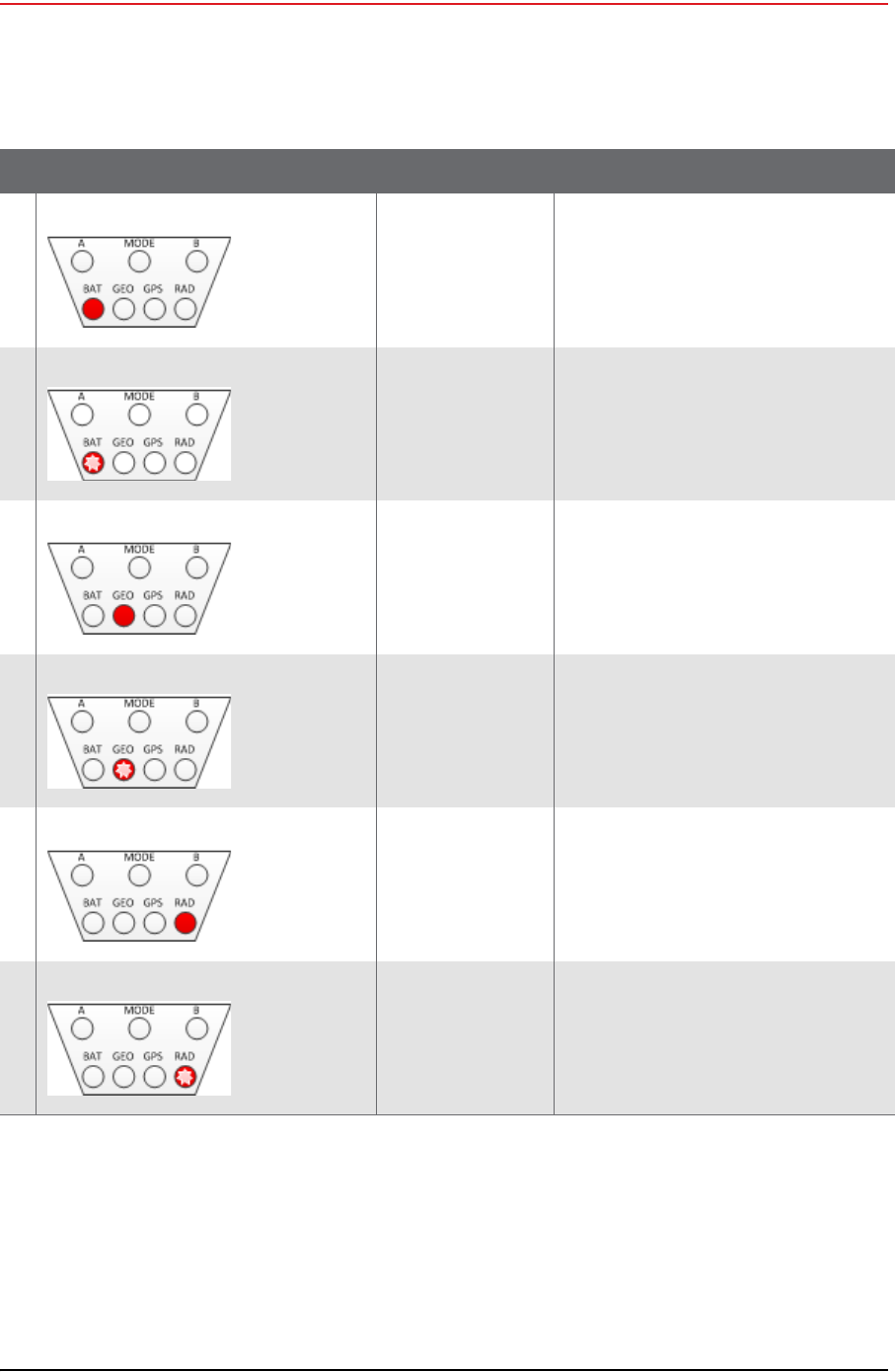
Draft
92 RT System 2 v2.0.0 Deployment Guide R00.e
© 2010-2012 Wireless Seismic, Inc. All rights reserved.
D. LED Indicators
3Update Arm Solid BAT
Approximately 30 seconds, then
repeats step 1 and step 2 LED
sequence
Programming/
Verifying Arm Flashing BAT
Approximately 30 seconds
4Update Xmega Solid GEO
Approximately 15 seconds, then step
1 and step 2 LED sequence
Programming
Xmega Flashing GEO
Approximately 15 seconds
5Update Radio Solid RAD
Approximately 1-2 seconds, then
step 1 and step 2 LED sequence
Programming
Radio Flashing RAD
Approximately 1-2 seconds
Table D–1 5Mbps WRU Power On Sequence LED Indications (cont.)
LED Indicators Summary Description

Draft
R00.e RT System 2 v2.0.0 Deployment Guide 93
© 2010-2012 Wireless Seismic, Inc. All rights reserved.
D. LED Indicators
Once the power on sequence is complete, the LED indicators in the following table
can be seen.
Table D–2 WRU LED Status Indications
LED Indicators Summary Description
Undeployed
Standby
Armed
Dead Batteries
If no LEDs are on (lit up), it can be one of the
following scenarios:
• Unit Undeployed
• Unit in Standby mode
• Unit in Armed mode
• Batteries dead
When you do a tilt test on a unit with no LEDs
on, the following may occur:
• An Undeployed unit deploys and begins
the self tests
• A unit in Standby mode displays an LED
error condition
• A unit in Armed mode will continue to
display no lit LEDs
• A unit with dead batteries will continue to
display no lit LEDs
NOTE: Battery state is shown in the
RT System 2 user interface tables. For
example, the Ground Equipment
Table.
Geo Down Tilt Detected All LEDs are on solid
Battery test in progress Flashing:
•MODE
•BAT
Battery A in use A flashing
Self test in progress Flashing:
•MODE
•BAT
•GEO
•GPS
•RAD

Draft
94 RT System 2 v2.0.0 Deployment Guide R00.e
© 2010-2012 Wireless Seismic, Inc. All rights reserved.
D. LED Indicators
Error LEDs remain persistent throughout the self-discovery process and are turned
off upon completion. If certain self-tests fail, it is possible that the WRU will power
down.
If a WRU self test fails, the WRU will continue to the next test.
Geophone test in
progress Flashing:
•MODE
•GEO
Acquiring GPS fix Flashing:
•MODE
•GPS
Neighbor discovery in
progress Flashing:
•MODE
•RAD
Neighbor discovered Flashing:
•A
•MODE
•B
Continue (lay flat to
move to next test) Solid:
•MODE
•GEO
•GPS
NOTE: To skip a test during the self-test
process, tilt the unit vertical
(geophone down) until you see this
triangle of LEDs. Tilt the unit back to
horizontal to continue.
Sleeping RAD flashing
Table D–2 WRU LED Status Indications (cont.)
LED Indicators Summary Description

Draft
R00.e RT System 2 v2.0.0 Deployment Guide 95
© 2010-2012 Wireless Seismic, Inc. All rights reserved.
D. LED Indicators
You can skip a self-test by tipping the WRU geophone down and then returning it
to the upright position (flat on the ground).
Table D–3 WRU LED Error Indications
LED Indicators Summary Description
Single battery failure
(B) A flashing
Solid:
•B
•BAT
Single battery failure
(A) B flashing
Solid:
•A
•BAT
Both batteries failure Solid:
•A
•B
•BAT
Self test failure Solid:
•BAT
•GEO
•GPS
•RAD
Geophone failure GEO solid
No GPS fix GPS solid
GPS fix within 10 m within 1 min not found
No neighbor detected RAD solid
If this is the first WRU deployed, this is the
expected condition.

Draft
96 RT System 2 v2.0.0 Deployment Guide R00.e
© 2010-2012 Wireless Seismic, Inc. All rights reserved.
D. LED Indicators
TBD
Table D–4 LIU LED Discipline Indications
LED Indicators Summary Description
Disciplining to radio Flashing:
•A
•RAD
Disciplining to GPS Flashing:
•A
•GPS
Disciplining A flashing
Disciplined to radio Flashing:
•B
•RAD
Disciplined to GPS Flashing:
•B
•GPS
Disciplined B flashing
Incorrectly dropped out
of cycle mode Flashing:
•A
•B
•BAT
•RAD

Draft
R00.e RT System 2 v2.0.0 Deployment Guide 97
© 2010-2012 Wireless Seismic, Inc. All rights reserved.
D. LED Indicators
Armed No lights
Table D–4 LIU LED Discipline Indications (cont.)
LED Indicators Summary Description
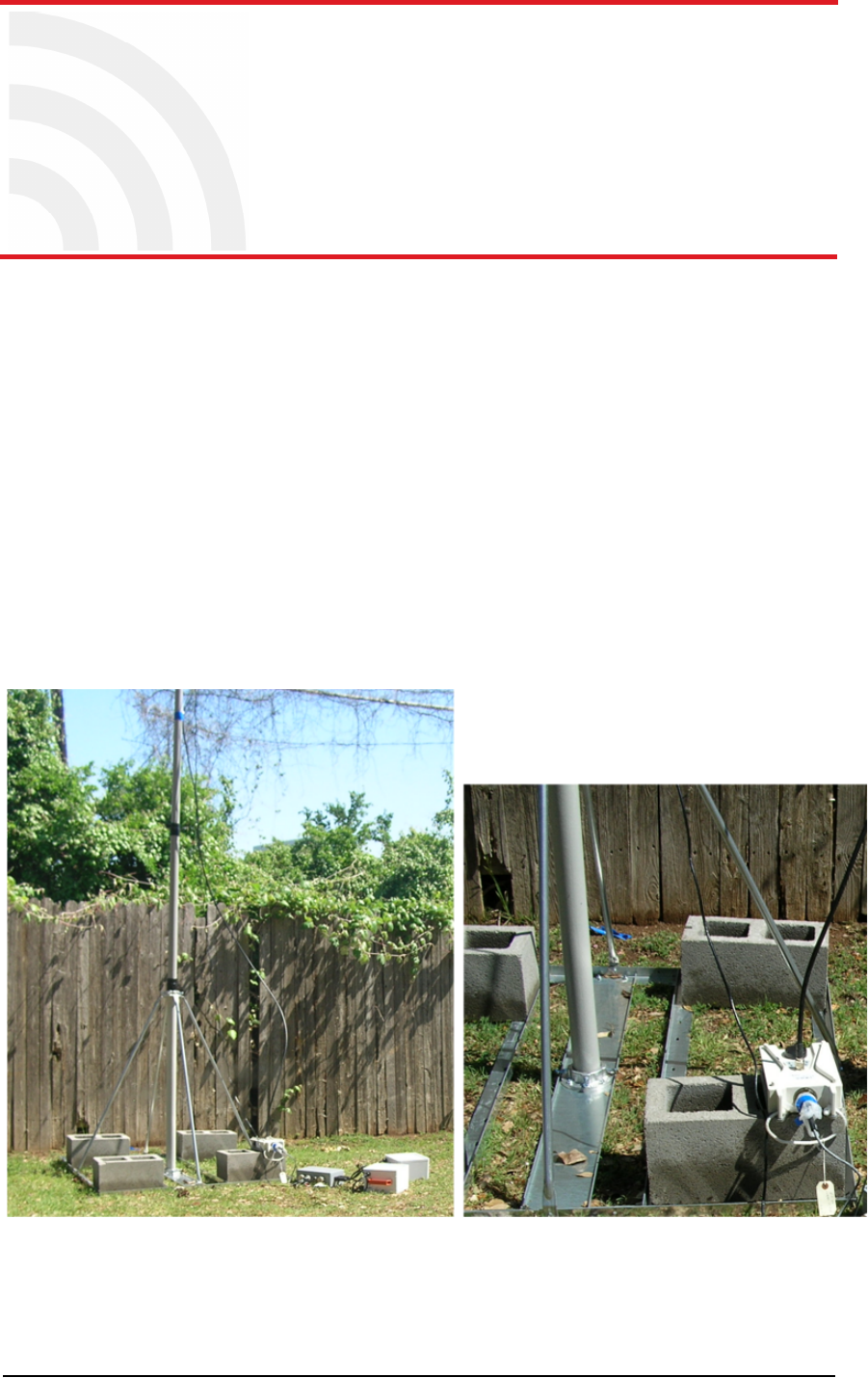
Draft
RT System 2 v2.0.0 98 Deployment Guide R00.e
© 2010-2012 Wireless Seismic, Inc. All rights reserved.
E
E. Weighted Mast
This section describes the mast that uses weights to maintain stability.
E.1 Specifications
Tripod Weight = 50 lbs (22.73 kg)
Minimum mast height = 53” (includes 6” for mounting)
Base size = 48” (1.2m) x 48” (1.2m)
Supports up to 12 – 16” x 8” blocks
Pre-galvanized steel frame
Accepts up to 2.5” mast (not included)
Figure E–1 Weighted Mast
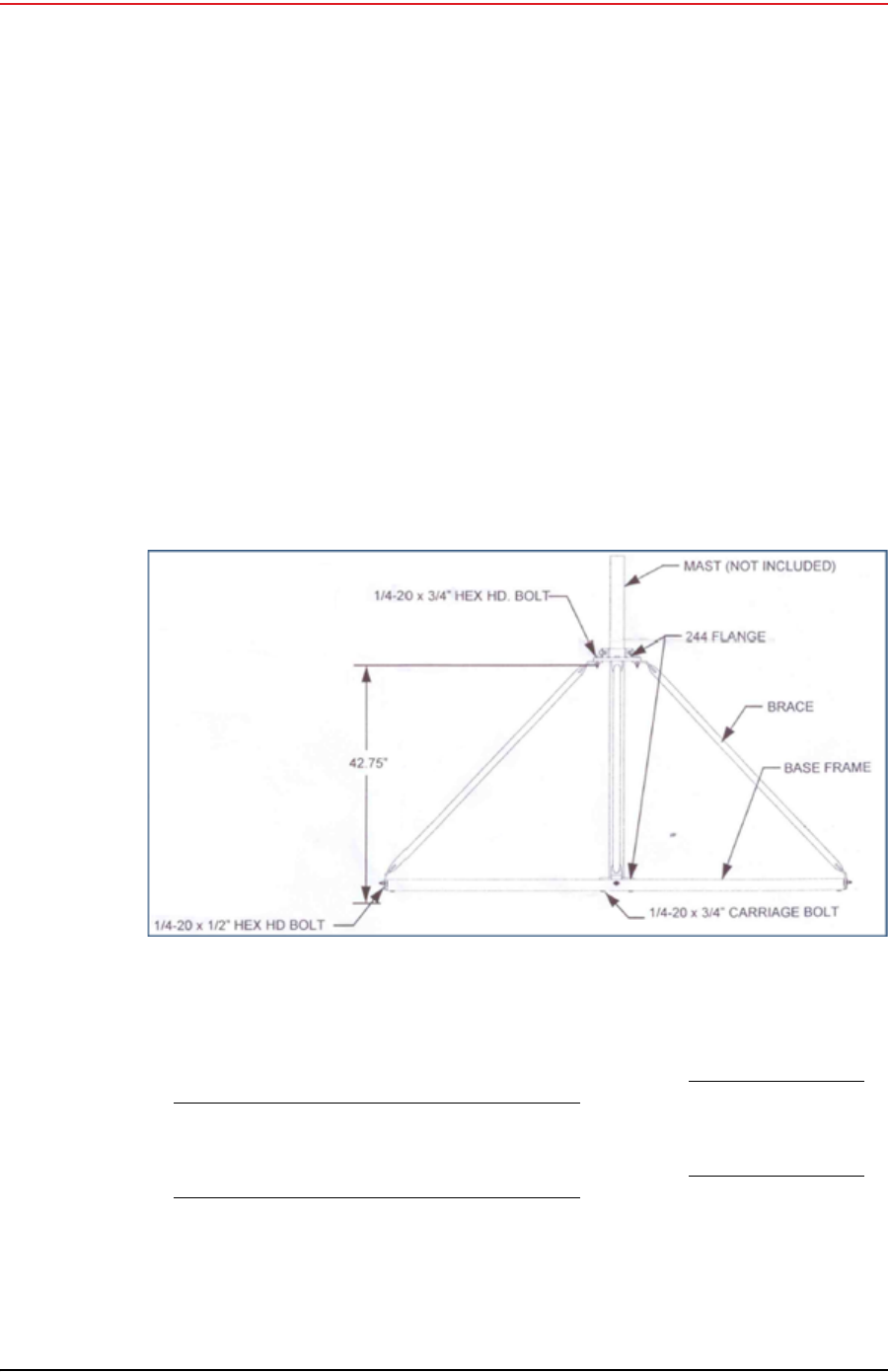
Draft
R00.e RT System 2 v2.0.0 Deployment Guide 99
© 2010-2012 Wireless Seismic, Inc. All rights reserved.
E. Weighted Mast
Hardware Supplied
E.2 Hardware Supplied
The following hardware is supplied with the tripod mast:
4 - Bolt, Carriage 1/4 - 20 x 3/4"
12 - Bolt, Carriage 1/4 - 20 x 5/8"
4 - Bolt, 1/4 - 20 x 3/4" Hex Head
4- Bolt, 1/4 - 20 x 1/2" Hex Head
24-Nut, 1/4 - 20
24 - Lock washer, 1/4 Int. tooth
E.3 Assembly Instructions
This section provides instructions and illustrations for assembly of the tripod.
To assemble the tripod:
1Assemble one 244 Flange to the Center Support Plate using four 1/4-20 x 3/4"
carriage Bolts, Lock washers and Hex Nuts. Make sure to assemble the Bolts
with the Heads on the underside of the frame. Hex Nut should be on the top
side of the frame.
2 Assemble Base Frame and Center Support Plate using twelve 1/4-20 x 5/8"
carriage Bolts, Lock washers and Hex Nuts. Make sure to assemble the Bolts
with the Heads on the underside of the frame. Hex Nut should be on the top
side of the frame.
3Assemble the four (4) Braces to the upper support flange using four 1/4-20x3/
4 Hex Head Bolts, Lock washers and Nuts.
Figure E–2 Tripod Assembly – Front View

Draft
100 RT System 2 v2.0.0 Deployment Guide R00.e
© 2010-2012 Wireless Seismic, Inc. All rights reserved.
E. Weighted Mast
Assembly Instructions
4Assemble the other end of the braces to the base frame using the four (4) 1/4-
20 x 1/2" Hex Head Bolts, Lock washers, and Nuts.
5Insert Bolts into upper and lower flange.
6Slide the mast (not included) into position and tighten securely and weigh.
Wade Antenna Ltd.
Ontario, Canada

Draft
RT System 2 v2.0.0 101 Deployment Guide R00.e
© 2010-2012 Wireless Seismic, Inc. All rights reserved.
Index
Numerics
192.168.0.10 30
2.4 GHz 23
4.9 GHz 30
5.1 GHz 30
5.8 GHz 23, 30
A
A 93
Acquiring GPS fix 94
antenna 11
connecting 19
specifications 29, 81
tips 20, 63
antennas 29, 81
auto-power-leveling 29
B
B 94
backhaul 23, 26
communication issues 64
masts 34
troubleshooting flow 64
backpack 36
bag 36
base 34
tips 50
BAT 93
battery
charger 71
charging 70
handling and safety guidelines 67
latch 17
remove 59
shipments 68
specifications 66
storage 69
tips 62
Battery A in use 93
Battery test in progress 93
bucket-brigade 23
C
Category View 37
central recording truck components 24
color 30
colors 48
communication tips 62
contact 10
Continue 94
CSS 23
D
datasheet 30
default IP address 30
disassemble the WRU 59
discharge 66
down tilt detected 93
E
error
Both batteries failure 95
Geophone failure 95
indicators 91
No GPS fix 95
No neighbor detected 95
Self test failure 95
Single battery failure (A) 95
Single battery failure (B) 95
example 25
deployment 54
extreme temperature charging 66
F
FCC 81
Section 15.203 81
firewall, turn off 36
FM1100 31
FM3100 31
frequencies 48
G
GEO 93
geophone 18
Geophone test in progress 94
GPS 93
disciplined 96
error 95
ground equipment 11
assemble 17
ground wire 28
H
help 9
hopping 23

Draft
Index
I
R00.e RT System 2 v2.0.0 Deployment Guide 102
© 2010-2012 Wireless Seismic, Inc. All rights reserved.
I
Icon View 37
Industrial, Scientific, and Medical radio band 23
IP address
Fluidmesh default 30
ISM 23
L
LED status 91
LIU Armed 97
Disciplined 96
Disciplined to GPS 96
Disciplined to radio 96
Disciplining 96
Disciplining to GPS 96
Disciplining to radio 96
error 96
kit 26
M
mast 98
erect 49
mast kit 33
masts 34
mesh
end 45
point 45
mesh networking 23
MODE 93
modifications 81
N
Neighbor discovered 94
Neighbor discovery in progress 94
Netmask 43
network
private 38
radio 38
restore settings 49
NIC 44
node 23
O
overcharge 66
P
PoE 23
injector 23
switch 23
power off WRU 58
Power over Ethernet 23
power-leveling 29
R
RAD 93
radio
band 23
color 30
configure 38
datasheet 30
install two 53
kit 29
network configuration 38
radios 23
relay 23
remove battery 59
repeater 20
restore network settings 49
S
self test 94
fails 21
in progress 93
short circuit 66
skipa self-test 21
a test 94
Sleeping 94
solid LEDs 93
specifications
antenna 29, 81
status
Acquiring GPS fix 94
Battery A in use 93
Battery test in progress 93
Continue 94
down tilt detected 93
Geophone test in progress 94
Neighbor discovered 94
Neighbor discovery in progress 94
self test in progress 93
Sleeping 94
Undeployed 93
string-of-pearls 23
supported
antennas 29, 81
Surge Protector 32
ground wire 28
install 33
T
tilt 93
tripod assembly 99
U
undeploy the WRU 58
Undeployed 93
urban environments 62
users 9

Draft
R00.e RT System 2 v2.0.0 Deployment Guide 103
© 2010-2012 Wireless Seismic, Inc. All rights reserved.
Index
W
W
Windows firewall 36
WRU 23
power off 58
power on 20
powers down 94
tests 21